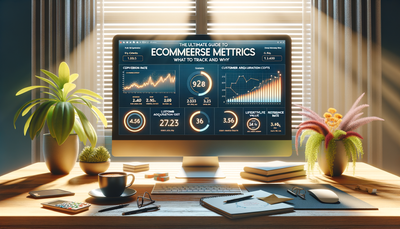Effective Call-to-Action Strategies for Business Websites
Effective call-to-action (CTA) strategies are crucial for driving conversions on business websites. These persuasive elements guide visitors towards desired actions, whether it's making a purchase, signing up for a newsletter, or requesting a demo. In this article, we'll explore proven techniques for creating compelling CTAs that boost user engagement and conversions. From design principles to copywriting tips and strategic placement, you'll learn how to optimize your CTAs for maximum impact. By implementing these best practices, you can transform your website into a powerful conversion tool, turning casual visitors into loyal customers and driving business growth.Table of Contents:

Understanding the Importance of CTAs
Call-to-action elements are the bridges between your website content and the actions you want visitors to take. They serve as clear signposts, guiding users towards conversion goals. Effective CTAs can significantly increase click-through rates, lead generation, and sales. By strategically placing well-designed CTAs throughout your website, you create multiple opportunities for engagement, reducing bounce rates and improving overall user experience.Moreover, CTAs provide valuable data on user behavior and preferences, allowing you to refine your marketing strategies and optimize your website for better performance. In essence, CTAs are not just buttons or links; they're powerful tools that can transform your website from a passive information source into an active conversion machine.
Do you need a website? Want to build a website but don't know where to start? Our website builder is the perfect solution. Easy to use, and with the ability to customize to fit your business needs, you can have a professional website in no time.
Designing Eye-Catching CTAs
The visual appeal of your CTAs plays a crucial role in attracting user attention and encouraging clicks. Use contrasting colors that stand out from your website's color scheme while maintaining brand consistency. Opt for button shapes that are easily recognizable, such as rectangles with slightly rounded corners. Ensure that your CTAs are large enough to be noticed but not so big that they overwhelm the page.Incorporate white space around your CTAs to make them more prominent and reduce visual clutter. Consider using subtle animations or hover effects to make buttons more interactive and engaging. However, be cautious not to overdo it, as excessive movement can be distracting. Remember, the goal is to make your CTAs visually appealing and impossible to miss without disrupting the overall user experience.
Crafting Compelling CTA Copy
The words you choose for your CTAs can make or break their effectiveness. Use action-oriented language that clearly communicates what will happen when users click. Start with strong verbs like 'Get,' 'Download,' 'Start,' or 'Join' to create a sense of immediacy. Keep your copy concise and to the point - ideally, no more than five words for button text.Incorporate benefit-driven language that highlights what users will gain by taking action. For example, instead of 'Subscribe,' try 'Get Exclusive Offers.' Create a sense of urgency with phrases like 'Limited Time Offer' or 'Only 3 Spots Left.' Personalize your CTAs when possible, using words like 'my' or 'your' to make the message more relevant to individual users. Always ensure that your CTA copy aligns with the content it's associated with to maintain context and relevance.
Building a website with SITE123 is easy
Strategic CTA Placement
Where you place your CTAs on your website can significantly impact their effectiveness. Consider the user's journey and place CTAs at natural decision-making points. Include a prominent CTA above the fold on your homepage to capture immediate attention. For longer pages, strategically place CTAs throughout the content, especially after presenting key benefits or features.Use a floating CTA button that remains visible as users scroll for continuous access to conversion opportunities. In blog posts or informational pages, place CTAs at the end of the content when readers are most engaged. For e-commerce sites, include CTAs near product images and descriptions to encourage immediate action. Remember to maintain a balance - too many CTAs can overwhelm users, while too few may result in missed conversion opportunities.
Optimizing CTAs for Mobile Devices
With the increasing prevalence of mobile browsing, it's crucial to optimize your CTAs for smaller screens. Ensure that your CTA buttons are large enough to be easily tapped with a finger - aim for a minimum size of 44x44 pixels. Use responsive design to adjust CTA size and placement based on screen dimensions. Consider using full-width buttons on mobile devices to maximize clickable area.Simplify your CTA copy for mobile users, focusing on the most essential information. Place mobile CTAs in easily accessible areas, such as the top or bottom of the screen, to accommodate one-handed browsing. Test your CTAs across various devices and screen sizes to ensure consistent functionality and appearance. By prioritizing mobile optimization, you can capture the growing segment of users who primarily access websites through smartphones and tablets.
A/B Testing and Continuous Improvement
To maximize the effectiveness of your CTAs, implement a robust A/B testing strategy. Experiment with different colors, shapes, sizes, copy, and placements to identify the most effective combinations. Use analytics tools to track click-through rates, conversion rates, and other relevant metrics. Test one element at a time to accurately determine the impact of each change.Don't limit your testing to just button design - experiment with different value propositions, urgency tactics, and surrounding content. Regularly analyze your results and apply insights to continually refine your CTA strategy. Remember that what works today may not work tomorrow, so maintain an ongoing process of testing and optimization. By embracing a data-driven approach to CTA optimization, you can consistently improve your website's conversion performance over time.





